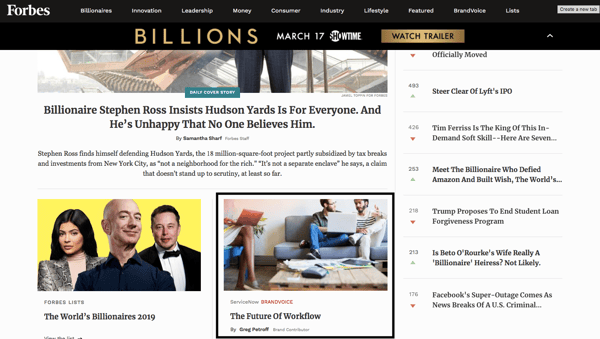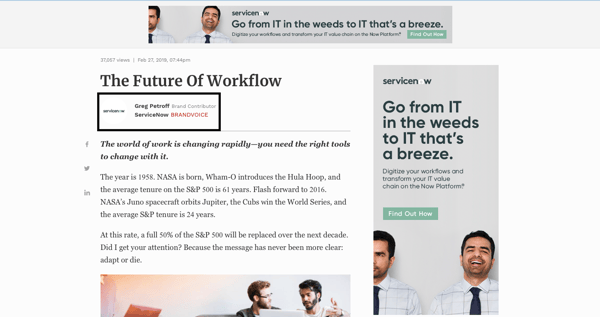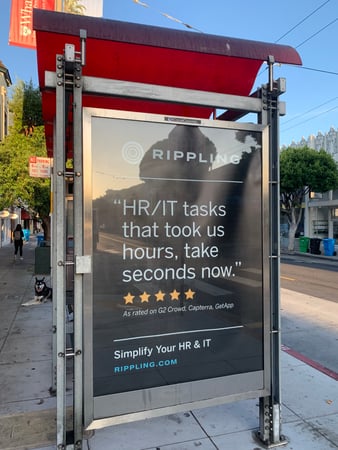

Consumers’ attention spans are shorter than ever, so how do you get your business to stand out from the crowd? The answer to that? Advertising.
Advertisements are everywhere, and it's difficult to imagine a world without them. Even in the most unlikely of locations, a business will find a way to place themselves in front of an audience. As a consumer, it can be challenging to establish what products are actually credible, and for businesses, it's even more difficult to establish credibility.
In the advertising world, credible is synonymous with effective. Businesses rely on graphic design techniques, along with research, to create engaging advertisements that match the wants, needs, and interests of their target audience.
Now, let’s get into what an advertisement actually is.
The prevalence of advertisements in society is hardly a coincidence. From the subway to public restrooms, businesses are engaging with consumers at every touchpoint in their lives, hoping to influence their buying decisions. The best advertisers use research to determine the placement, style, and purpose of an ad.
Advertising is the process of persuading a targeted audience to take a specific action, whether that’s buying a product or bringing awareness towards an issue. An advertisement, is considered messaging that attempts to engage and influence an audience.
While some ads are slipped seamlessly into our daily lives without notice, others create an entire experience. Whatever type of advertising a business chooses, the end goal of all advertisements are the same—to influence the behavior of an intended target audience.
While most people assume that advertising is all about getting consumers to buy certain products, there are numerous motivations behind advertising. Businesses and organizations will use ads to influence the opinion of a target audience or cultivate awareness towards specific issues.
Sometimes advertisements won't even mention a specific product; they may simply attempt to forge a relationship between consumers and a brand, such as this video ad from Always.
Just as advertisements vary in purpose, they're also diverse in style and form. Prior to creating an ad, advertisers will spend valuable time understanding the behavior and interests of their target audience. One of the most important insights an advertiser can gain from this research is ad placement. Especially with the rise of digital media, there are seemingly endless possibilities for businesses to reach an audience. However, choosing which type of advertisement, whether it's a TV commercial, paid social media posts, or print ad, can be more influential than the visual aspects of the advertisement.
Most people struggle to differentiate between marketing vs advertising, but it's relevant for businesses to recognize they are not synonymous.
It is helpful to think of marketing as a large umbrella, and the entire process of getting an audience interested in a product or service falls under it. Advertising is just one of the many subsets that contribute to this process.
Just as with most things in life, if you're just "winging" it, it's going to be difficult to succeed. Organizations understand that every action they take comes with potential collateral, so they strategize to avoid any mishaps for investors or the overall success of the business. A marketing plan that lays out all of their marketing efforts and implementation methods is typically developed before the execution of any activities.
Research is an important first step in any marketing plan since it provides marketers with the insight they need to execute a campaign effectively. Once a business understands its market and potential customers, they’re able to develop assets and define a brand that will speak to their audience. From there, advertising is able to do its job.
Our world has never been more digitally connected, so if you’re not advertising online, then your business is probably behind the curve. According to a 2018 study by Nielsen , the average American adult spends more than 11 hours per day interacting with media in some capacity. If the ultimate goal for a business is to inform and connect with consumers, then they need to engage with them digitally.
There isn't any specific method or approach that a business should use to reach their targeted audience. Businesses, especially large corporations, allocate tremendous amounts of their budget to receive insight into the habits, needs, interests, and characteristics of their ideal consumers. Once personas are established, the where and how of advertising can be determined.
Since there are multiple types of online advertising, here are some types of digital advertising you can discover to choose which is best for your business.
In this day and age, it can sometimes feel like we are overloaded with information. Imagine you're a consumer searching for the best dog leash, whether you’re using Google, Yahoo, or Bing, when you search for the term “the best dog leash,” the search engine responds with thousands of links to choose from. Most consumers aren’t going to shuffle from page to page when choosing which leash they want to buy. In contrast, they'll most likely pick one of the first links, since the link’s position establishes credibility in the consumer’s buying process.
This is where paid search comes in.
Paid search's pay-per-click (PPC), or search engine marketing (SEM) involves the process of bidding on keywords so that advertisements are placed either at the top, bottom, or sides of search results. Through paid search, you'll be able to position yourself directly in front of consumers who are searching for topics relevant to your business.
Over time, social media has evolved into the perfect landscape for businesses to put themselves in front of an engaged audience. Businesses either implement social media ads through boosted or sponsored posts, which are proven to convert consumer engagement into buys. For instance, check out this Instagram ad from Wayfair. When users engage with the ad, they can then click on the item they like, see details of the products, and be taken directly to the Wayfair website to purchase the product.
Social media usage is broad. Imagine how different the interests of 31-year-old new mom are from the interests of a 19-year-old college athlete. Placing random content in front of users isn't going to perform well, which is why platforms like Facebook, Twitter, LinkedIn, and Instagram all offer features that allow businesses to micro-target their content based off certain demographics and behaviors.
It is also essential to consider buyer personas when selecting which social platform to advertise on. Being relevant to your target audience is essential, so you should know where they are accessible and engage with the most. When the demographics of the channel match your brand, you're not only selling a product, but also creating a social following.
To create social ads that convert, many marketers use reviews and data from customer review platforms in their social media ads.
Customer reviews provide a source of content that can be used in by B2C and B2B brands, in both marketing and advertising.
With so much content out there, consumers have learned to ignore advertisements and focus on the parts of the media that are most valuable to them. Some businesses will implement native advertising since their ads can influence consumers while almost going unnoticed.
Native ads are designed to follow the function and form of the content on the page on which it appears, making it harder to ignore. Native ads not only engage consumers in a unique way, but they’re also another medium for a brand to put themselves in front of their target audience.
Take this article from Forbes, for example. Take this article from Forbes, for example. On the landing page, Forbes has attached the "brand voice" label to this article to signify that to readers that this was paid for by a brand. Once readers click-on and open the article, Forbes clearly displays that the "brand voice" is the company, Service Now. Service Now has also paid for display and banner ads to accompany their native ad. Presumably, this brand chose to position themselves in Forbes based off of market research, which led to the conclusion that its target audience consumes this magazine.


Banner ads follow the same format as PPC but are more visually engaging. Within the advertising industry, they can be viewed as outdated due to their distracting manner. However, when designed and used strategically, they can help businesses achieve their objectives.
As shown below, banner ads are typically boxes placed horizontally on the top of the web page, while display ads are shown on the side.
Today, many consumers will employ ad blockers to avoid seeing banner and display ads, which has become a tremendous issue for businesses who rely on this form of advertising for revenue. While advertisers have started to do away with the use of banner and display ads, they still are worth mentioning because of the potential lesson their extinction can teach businesses.
Advertising, like many other fields, is constantly evolving. In order to stay relevant and credible to consumers, businesses must adapt their tactics to match the evolving interests and habits of society.
With so many possibilities for advertising, how does a business create something effective?
Nearly every ad has an objective behind it, whether it’s to stand out from competitors or increase sales. However, the best advertisements go above and beyond while considering how they encourage consumers to feel or achieve something. Think of Nike's Just do it or Coke's share a Coke campaign. These advertisements were not explicitly saying buy our product, but they appealed to the emotions of consumers by giving them an implicit reason for consuming their brand.
When advertisers tap into the emotions of an audience, they’re fostering more than just a sale; they’re creating a consumer-brand relationship. People today have more buying control than ever, which is why businesses strive to build brand loyalty. The most successful advertising campaigns bring in a new audience while simultaneously reminding current customers of the reasons why they use and appreciate the brand.
Ads that provide social proof build credibility and trust, another way to find success. Here you can see an image of an outdoor ad centered on a review:

While people lack trust in marketers and advertisers, they do trust their peers -- even those they haven't met. Reviews are unfiltered and transparent, meaning people will believe the promise of an ad created with customer reviews.
| TIP: Ad servers provide awesome benefits to every advertising campaign. Learn the top 5 advantages here! |
Plus, reviews take away the time and cost of copywriting: The customer has done it for you. If you're a B2B software or service provider, a free profile on G2 will connect you with over 3 million buyers, giving you content for ads, and a place to direct customers to read more content and increase sales.
Want to start creating your next advertisement? Check out the best free graphic design softwares of 2019 to help boost your creativity in ad creation!
Emily Goorevich is a former content marketing intern at G2, and currently works as an SEO Specialist at L2TMedia. She is originally from Maryland, and loves reading, listening to podcasts, and eating falafel.
Licking a tub of ice cream. Eating Tide Pods. Hoverboards. The cinnamon challenge.
 by Daniella Alscher
by Daniella Alscher
So you’re considering advertising on Facebook, huh? Well you've come to the right place.
 by Alexa Drake
by Alexa Drake
Licking a tub of ice cream. Eating Tide Pods. Hoverboards. The cinnamon challenge.
 by Daniella Alscher
by Daniella Alscher
So you’re considering advertising on Facebook, huh? Well you've come to the right place.
 by Alexa Drake
by Alexa Drake
Never miss a post.
Subscribe to keep your fingers on the tech pulse.



